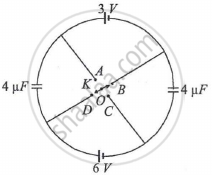Advertisements
Advertisements
Question
A charge +q exerts a force of magnitude -0.2 N on another change -2q. If they are separated by 25.0 cm, determine the value of q.
Solution
Given: q1 = + q, q2 =−2q, F = – 0.2 N, r = 25 cm = 25 × 10−2 m
To find: Charge (q)
Formula: F = `1/(4πε_0)("q"_1"q"_2)/"r"^2`
Calculation: From formula,
– 0.2 = `(9xx10^9xx"q"xx(-2"q"))/((25xx10^-2)^2)`
∴ `(- 0.2)/(- 2) xx (25 xx 10^-2)^2/(9 xx 10^9) = "q"^2`
∴ `0.1 xx (25 xx 10^-2)^2/(9 xx 10^9) = "q"^2`
∴ `1/10 xx (25 xx 10^-2)^2/(9 xx 10^9) = "q"^2`
`∴ (25 xx 10^-2)^2/(9 xx 10^10) = "q"^2`
∴ `sqrt((25 xx 10^-2)^2/(9 xx 10^10))` = q
∴ `(25 xx 10^-2)/(3 xx 10^5)` = q
∴ q = 8.33 × 10−7 C
or q = 0.833 × 10−6 C
∴ q = 0.833 μC
APPEARS IN
RELATED QUESTIONS
Choose the correct option.
Which of the following produces uniform electric field?
Solve numerical example.
Calculate the electric field due to a charge of −8.0×10−8 C at a distance of 5.0 cm from it.
The number of electrons to be put on a spherical conductor of radius 0.1 m to produce an electric field of 0.036 N/C just above its surface is ____________.
An electron is moving towards X-axis. An electric field is along Y-direction then path of electron is ____________.
An electron at rest is accelerated by a potential 'V1', in uniform field experiences a force 'F1'· When potential is changed to 'V2', the force experienced by the electron gets doubled. The ratio of V1 to V2 is ______.
An electron experiences a force equal to its weight, when placed in an electric field. The intensity of the field will be ______.
The magnitude of point charge due to which the electric field 30 cm away has the magnitude 2 NC-1 will be ____________.
Two parallel plates separated by 'd' mm are kept at potential difference of 'V' volt. A particle of mass 'm' and charge 'q' enters in it with some velocity. The acceleration of the particle will be ______.
The energy density of a medium is 3.54 x 10- 5 J/m3. The intensity of electric field in the medium of dielectric constant 2 is ______.
A large metal plate of area 1.0 m2 is placed in electric field. The magnitude E of the electric field is 5.5 N/C. What is the magnitude of charge on the plate?
Electric field at the centroid of a triangle carrying q charge at each comer as
Dimensional formula for electrical field is ______
A copper ball of density 8.6 g/cm3, 1 cm in diameter is immersed in oil of density 0.8 glcm3. The charge in µC on the ball, if it remains just suspended in an electric field of intensity 3600 V/m acting in upward direction is ______ µC.
A positive charge particle of 100 µg is thrown in opposite direction to a uniform electric field of strength 1 × 105 NC-1. If the charge on the particle is 40 µC and the initial velocity is 200 ms-1, how much distance it will travel before coming to the rest momentarily:
An oil drop of radius 2 mm with a density 3 g cm-3 is held stationary under a constant electric field 3.55 × 105 V m-1 in the Millikan's oil drop experiment. What is the number of excess electrons that the oil drop will process?
Consider g = 9.81 m/s2
An inclined plane makes an angle of 30° with the horizontal electric field E of 100 V/m. A particle of mass 1 kg and charge 0.01 C slides down from a height of 1 m. If the coefficient of friction is 0.2, the time taken for the particle to reach the bottom is ______ sec.

The electric field in a region of space is given by, `vec"E"= "E"_"o"hat"i" + 2"E"_"o"hat"j"` where Eo = 100 N/C. The flux of the field through a circular surface of radius 0.02 m parallel to the Y-Z plane is nearly ______.
In figure, there is a four way key at the middle. If key is shown from situation BD to AD, then how much charge will flow through point O?

The expression for electric field intensity at a point outside uniformly charged thin plane sheet is ______. (d is the distance of point from plane sheet)
Consider the following statement about the electric field the intensity and the electric potential.
- The electric field intensity due to a charged spherical shell is inversely proportional to the square of its radius.
- The electric potential due to a point charge is inversely proportional to the distance between the charge and the point.
An electron of mass me and a proton of mass mp are kept in a uniform electric field. The ratio of the acceleration of electron (ae) to the acceleration of proton (ap) is ______.
Which of the following configuration of electric lines of force is not possible?
